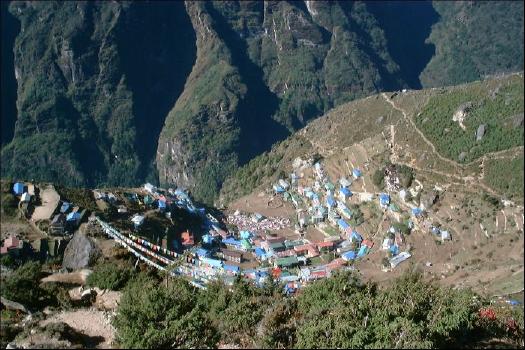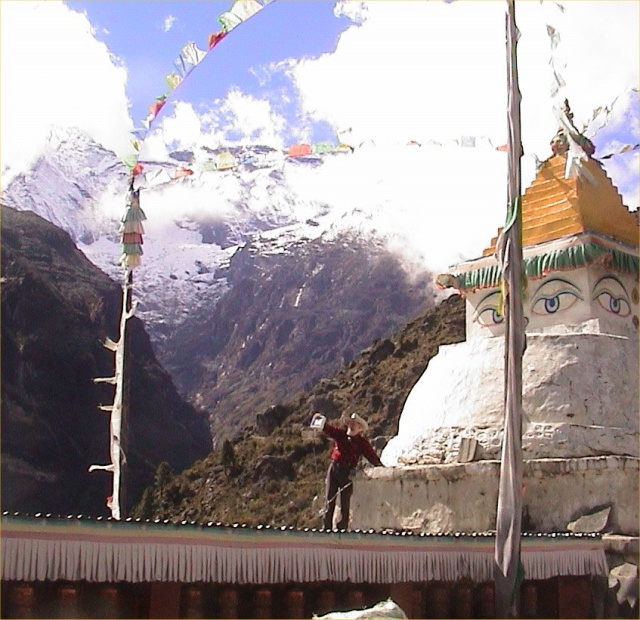Another Call from Mount Everest
I thought I was done with doing my duty for the Sherpas, Cisco, and the Celebration of Mount Everest in 2002.
Before long I would be in Namche, Nepal at 14,000 feet and above

But Tsering Sherpa was not done. He saw the power of the Wireless connectivity - and what it could do to bridge both the mountains gap, and costs trying to connect up any of the high mountain villages, even to ordinary voice telephone service. To complicate things, the Red Maoists of Nepal had - in one of their acts of Terrorism, blown up one of the only telephone systems in the high mountains. No basic telephone service in or around Namche or the trekking route. Tsering had an idea.
He contacted me by email again and asked if I could do anything to help his people with one problem. Unless Sherpa youth learn some oral English, they are doomed to spend the rest of their lives carrying heavy loads for Westerners for $5 a day.
Only a few Sherpas who grew up - like Tsering - along the trekking corridor from Lukla to the the high country ever got a chance to go to Kathmandu and to a 'private' school to learn English. With which they could become guides, give more help to foreigners, deal better with crises involving English speaking trekkers and climbers. Even escape their mountain fastness for better lives. For the Sherpa parents along the main trekking corridors could afford to build Lodges serving foreigners, make enough money to send their kids to private schools down in the Nepalese capital of Kathmandu where they learned English. But any Sherpa families who lived even as close as 4-5 miles from Namche rarely saw foreigners - who, above 10,000 feet don't wander around much,
Tsering asked if I could help him, using the Internet, help teach Sherpas oral English. Wow!
I knew a way - a very complex way, which would require lots of technological savvy, and a trip by someone to 15,000 foot Namche, Nepal with other type radios.
But I also knew two other things. Since I lived at 6,000 feet in Colorado I would not be bothered spending some time at 15,000 feet. My lungs are pretty aclimated to altitude. And the other was that I lived only 10 minutes from the Barr Trail base of Pikes Peak. I could get my 75 year old Korean War infantry legs in shape to trek for three days to at least the level of Namche, where the technology would have to get installed.
I knew I would have to install, and get instruments for VOICE over IP - called VOIP. As well as find a Sherpa who knew English, and Internet Communications enough, to do the job whereever he lived.
So I said to myself - and my alarmed kids - THIS is a job for me! Even my pretty technical grown kids would not have all the skills - that I had learned in wireless - to do the job. I would fly to Nepal trek at least to Namche, install the radios, and trek back. I would donate all the needed equipment. Perhaps to be paid back by Tsering some day.

Me on the porch of a Stupa in Namche, checking radio line-of-sight. The mountains behind me are at 22,000 feet.
Preparations
So I set out to prepare physically, economically, technologically.
Physically my preparations were straightforward - I rose very early every morning, drove 10 minutes to the foot of Barr Trail that ascends toward the top of Pikes Peak just beyond Manitou, and started hiking at first light up the trail - recording my distance and times, up and down. I starting doing one hour up and down, until I was doing 2 hours up and down, passing, or being passed with all sorts of people doing the same thing. So many of them brought dogs that I considered writing a piece called "The Dogs of Barr Trail" I climbed alone, and was back home for a shower and late breakfast with Patsy.
I hadn't climbed that way since 28 years earlier when I climbed 14er Mt Sherman during the Colorado Centennial. But my legs seemed to remember well enough, so it was just a matter of progressive conditioning.
I knew I would need at least two VOIP phones, and my best bet seemed to be phones from Cisco. Having gotten them good publicity, I tried to see if they would shake loose with three. Engineer Jim Forester came through with them, gratis. Later I learned some characteristics of their phone software that made them less than desirable.
But Jim Forester of Cisco really wanted this project to work - so he donated, out of his own pocket the price of a Windows 386 class computer which they could buy in Kathmandu, that I would reimburse, get it to Namche and to whatever outlying village the classes would be held for it to handle the Internet signals, sound and with microphone.
I then chose to get, and buy 5 wireless Wi-Fi radios, not from Cisco, but from a company in Singapore, through a dealer in Denver. They were called SmartBridges. I had studied their characteristics, their reliability, the range of temperatures they could handle, their 'user' configuration interface - for once I had installed them in Nepal, it would be up to Tsering and others to configure, troubleshoot and maintain them. I discovered they were cheaper than Cisco Aeronets, just as good, far simpler to configure than Ciscos which really assumed their would be installed and operated by skilled people, or radio engineers.
But then I hit the BIG difference that made me buy them. The Smart Bridges radios required 12 volts of power, while Ciscos required 24 volts! 12 Volts is 'car battery' power, while 24 volts would require - high on Mount Everest - TWO car batteries connected together for each radio that had to depend on them for power on a mountain side - even if they were recharged by small solar panels.
I knew I could not carry car-sized batteries by air into Nepal. I assumed, and was right, that Tsering could round up some - even if they had to be carried up from Kathmandu. I asked him and he said yes, that he could get them from Tibetans who came down every year in season to set up the Tibetan Marketplace in Namche for all those trekkers who would pass through, resting for 2, sometimes 3 days there.
I asked Tsering to check and tell me what 'amp hours' those batteries would have. I laughed when he came back with "We don't know. For they are Chinese Batteries and nobody in Namche could read or write Chinese characters on the batteries he saw" So I had to just use my best technical judgment to calculate the solar panel production, amp hour rating, recharge time, and probable hours of sunlight.
Then I tracked down the most important ingredient - a Sherpa who lived in Pittsburgh, PA, was related to Sherpa's in Colorado, had a technical job after college in PA, spoke and could write Nepalese - which any students would know, as well as English. Mingma Sherpa, who was originally from Namche, so knew his people there, and agreed to teach some Sherpa youth, English.
He came to Colorado Springs as part of a trip to see relatives. I learned there were MANY Sherpas living in Colorado - Boulder where there is a Bhuddist Temple, Colorado Springs where some were in business, and in the mountains going to Colorado Mountain College.
Meanwhile I had come across a very new technology, which was reputed to be very reliable, required only 32bits of Bandwidth, rather than the 64 bits required by Cisco Voip phones. It was called Skype! Brand new. And it did NOT require hardware other than a computer at both ends, with a free downloaded Skype software, a microphone and a speaker or ear phones. (by the time I am writing this in 2011 Skype is world wide with millions of simultaneous users)
Since Tesring still had his Cybercafe in Namche, with computers attached to it, I told him how to download the Skype software, which he did, while I set up mine - and voila! We thereafter talked voice - with the voice delays going up/down from Namche and beyond, through a satellite 22,000 miles up, then down to a Nepalese based Satellite service in Kathmandu called 'World Link' then up from there to another satellite over the Pacific to Hawaii, by underseas cable to California, then across the US to Pittsburgh. Which caused delays during talking over that distance.
So Mingma, and I met at my Old Colorado City Communications offices where my Internet servers were, scheduled in advance by email with Tsering half the world away time zone (I recall we were 11 hours difference), and tested the link. Tsering even had four Namche school children with him listening to the speaker and answering Mingma - in Nepalese. Everything worked, even though there was a two-hop delay - almost 2 seconds before the person at the other end heard what was said here, and then the same delay coming back. THAT takes getting used to!
Then my part time employee, Marty Yazlowitz and I carefuly configured and tested all the radios, setting them up with the IP's provided from Nepal.
With everything packed in a footlocker sized case I got at Wallmart, my Visa and Passport in hand, my Quatar Airlines reservation, I was ready to go!
 h
h
Mighty Everest itself, at 29,028 feet high. Looking directly at it from just above Namche. Its about 40 miles further up the trekking trail further.
Now rather than duplicate here the story of that Mt Everest Venture, I had separately created and registered a companion web site "Linkingeverest.com' that tells the complete story fully illustrated. Just go the following link, and then select the "Hughes Expedition' gallery and page through it. And then go through all 51 images and commentary under the "Distance Learning for the Sherpas in Nepal." Near the end of that set you can actually listen to Mingma Sherpa talking to Tsering and some kids in Nepal over Voip and wireless.
http://gallery.linkingeverest.com/main.php
Later in 2004 I was contacted by a New Delhi Indian technical publication, asking me to write an account, which they published as "Insight: Wireless Network in the Himalayas" Here it is as a PDF file.
Wireless Network in the Himalayas
